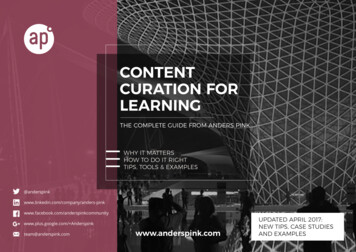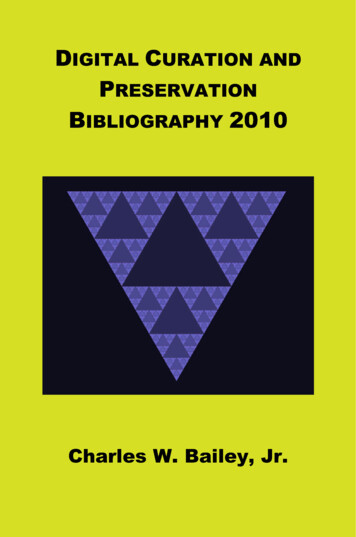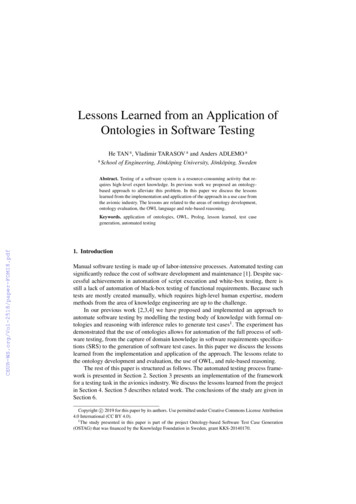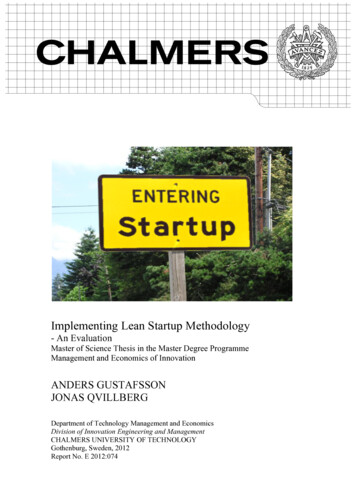
Transcription
CONTENTCURATION FORLEARNINGTHE COMPLETE GUIDE FROM ANDERS PINKWHY IT MATTERSHOW TO DO IT RIGHTTIPS, TOOLS & google.com/ ATED APRIL 2017:NEW TIPS, CASE STUDIES1Content Curation For LearningAND EXAMPLESwww.ande r s p ink.co m
TABLE OFCONTENTSFOREWORDS:PAGE 3INTRODUCTION:PAGE 5Don’t Wake Up Dumber Than You Went To Bed!PAGE 8PART 1:Why Content Curation Matters For Learning0102030405Our skills have a shelf-life: Don’t be AT&TTo stay smart, we need to look beyond traditional trainingTo stay smart, we need continuous learningWe learn better together: the power of collective intelligenceThe Content Shock Problem: Too much Content, Too Little TimePAGE 21PART 2:Why Learning Professionals Can Be theCuration HeroesPART 3:What Skills Do Content Curators Need?PAGE 29PAGE 34PART 4:Curating Content for Learning: 10 Steps for Success01020304050607080910Agree Business Drivers and Success Criteria for CurationDefine your target audienceSet a Baseline for CurationStart Knowledge DiscoveryFilter Effectively: Use AutomationMake Sense and Add ValueShare - Right Content In Right ChannelsCollaborate - Get Teams To CurateMake it Stick: Build Daily Curation HabitsKeep it Fresh: Get Feedback and RefinePAGE 105PART 5:Content Curation in Learning: 26 ExamplesContent Curation For Learning2www.ande r s p ink.co m
FOREWORD:FROM JANE HARTThese are challenging times for business. 72% of CEOs believe the nextthree years will be more critical for their industry than the last 50.What does this mean for learning? If learning is going to keep pace with thatchange, my view is that we need a rethink. Traditional learning has focused onprovision of static formal courses and training. They don’t reflect how most people actually learn, and they lag behind emerging trends. If Uber, AirBnB andother disruptive innovations tell us anything, it’s that if we don’t keep pace withchange, our skills will become obsolete, along with our companies.There is a better way. Instead of providing fixed courses, we can help peopleto learn continuously. That means supporting a culture which looks externallyfor insights. That means finding, filtering, and sharing the most recent, mostrelevant content that will give our teams a competitive advantage. That means amindshift from creation of formal learning to curation for continuous learning.I’ve spent 25 years championing the move towards modern workplace learning.In this guide, Anders Pink set out practical ways to make that a reality with continuous and curated learning that’s embedded in the workflow and keeps pacewith change.Learning Professionals can reinvent themselves and become more relevantthan ever in these turbulent times. They can become the heroes of continuous,curated learning and help their organisations stay agile. I hope you’ll take on thepractical tips in this book for doing just that.JANE HARTFounderCentre for Learning &Performance Technologies@C4LPTContent Curation For Learning3www.ande r s p ink.co m
FOREWORD:FROM ROBIN GOODCURATION IS ABOUT TO REVOLUTIONIZEEDUCATION AND LEARNING AS WE KNOW IT TODAYNew startups curate alternative learning paths from existing courseofferings, learning professionals have started to curate their own contentand learners are discovering how effective it is to learn by having to makesense of a topic rather than having to simply memorize facts about it.Not only. Curation helps learners develop critical analysis skills and to evaluatemultiple viewpoints before making their own mind, preparing them for a futurewhere it will be increasingly harder to tell truth from fiction. At the same timecuration helps learning professionals to discover and utilize rare and hard to findresources that can complement the materials they prepare.Organizing, collecting, preserving and making-sense of our discoveries, knowledge and visions is a critical task facing humanity in a time where, notwithstanding the amount of technology we have available, we keep giving priority to production rather than to better understand, analyze and distill the infinite amountof valuable knowledge we already have available.Above all curation helps everyone in making sure that the good stuff we createand publish doesn’t not get lost in the ocean of content that gets shared everyday, while providing perspective, context and extra depth to it through the commentary and opinions of those who invest their time doing it.Curation is a gateway to understanding better whatever we may be interested in,and curators will be our “trusted guides” into this learning journey.ROBIN GOODContent Curation Expertrobingood.com@robingoodContent Curation For Learning4www.ande r s p ink.co m
INTRODUCTION:DON’T WAKE UP DUMBER THANYOU WENT TO BED!Content Curation For Learning5www.ande r s p ink.co m
INTRODUCTION:DON’T WAKE UP DUMBER THAN YOU WENT TO BED!Do you ever feel you wake up dumber than you went to bed? We all do. The rate of contentproduced every day far outpaces our ability to keep up with it. We’re all drowning. And in allthe noise, distraction and low-value content, we’re missing the good stuff. And that meansour skills and knowledge is becoming less valuable. That’s a dangerous position to be in.But there’s something we can do about it. We can find, filter and share content moreeffectively to stay smart. If you’re a learning professional, you can do it for your internalteams. We argue that content curation is the new essential skill for learning professionals.In this ebook we set out why curation matters for learning, and how to do it effectively.WHAT IS CONTENT CURATION?You’re probably already wearing multiple hats. And beforeyou add a Content Curator one, you’re right to ask: What iscontent curation, and what has it got to do with learning?Let’s start with definitions. We like this one from RohitBhargava, shared by @robingood:“A content curator is someone who continuallyfinds, groups, organizes and shares the bestand most relevant content on a specific issueonline. The most important component of thisjob is the word continually.”To expand on this, content curation for learning means Finding the best content from multiple sources,usually external content Filtering it so only the most relevant content makesit through Sharing it with the right internal audiences, at theright time, in the right places Adding value to that content with commentary,context or organisationContent Curation For Learning6www.ande r s p ink.co m
INTRODUCTION:DON’T WAKE UP DUMBER THAN YOU WENT TO BED!WHY DOES IT MATTER FOR LEARNING PROFESSIONALS?We get it. You’re busy. You’re under pressure to deliver. Why divert time to consider content curation as another newconcept, when you could focus on any number of other learning initiatives? We may be biased, but we think traditional,course-driven approaches to corporate learning are no longer sufficient in the new economy. We need a better way ofstaying smart. In this book we look at Why we all need content curation to stay smart Why Learning Professionals are the ideal content curators How to curate content for learning in practice Case studies and examples to inspire youWe’re passionate about staying smart through content curation. We’ve built Anders Pink as a curation tool because weneeded it for ourselves, and we’re very happy to share it freely with you and your teams too. There are lots of great toolsout there - we encourage you to explore and find what works best for you. And we’ll keep sharing all the tips and curatedcontent we’re putting together - we’re smarter if we all work together.Stay Smart!Anders underSTEVERAYSONCo-founderContent Curation For Learning7www.ande r s p ink.co m
PART 1:WHY CONTENT CURATIONMATTERS FOR LEARNINGContent Curation For Learning8www.ande r s p ink.co m
PART 1:WHY CONTENT CURATION MATTERS FOR LEARNINGCONTENT CURATION MATTERS TO TEAMS, INDIVIDUALS AND BUSINESSES. HERE ARE FIVE REASONS WHY.For proof, read Exponential Organisations – Why NewOrganisations Are 10x Faster, Better and Cheaper thanyours (and what to do about it). It’s a sobering read foranyone who thinks they’re on top of their game:1OUR SKILLS HAVE A SHELF-LIFE: DON’T BE AT&TIf you want to stay earning, keep learning.If you worked for AT&T 30 years ago, you were probably feeling pretty good about things. You wereworking for the company that once owned the patent for the telephone. How cutting edge can you get?You were trained once at the start of your career, and that stood you in good stead until retirement. Skillsfor life, a job for life. Learning is for newbies.Flash forward a few decades. AT&T find themselves fighting to survive. They’re chasing the tails ofcompanies less than 10 years old, and losing to them. What happened? In simple terms, they didn’t keepup with changes in their industry. They got Ubered (or in their case, Googled, iPhoned and Amazoned).Think back on any piece of knowledge, training or skills you acquired 10 years ago, or even 1 year ago. Howrelevant is the content today? To make the lesson of AT&T personal: whatever skills and knowledge havegot you this far in your career are not going to get you or your company to the next stage. The average shelf life of a business competencyhas dropped from 30 years in 1984 to 5 years in2014 89% of the companies on the Fortune 500 list in1955 were not on the list by 2014 The average lifespan of an S&P 500 company hasdecreased from 67 years in 1920 to 15 years today In the next 10 years, 40% of all S&P 500 companieswill disappear from the listWhat’s happened? Models are changing: New entrants such asAirBnb, Uber, Amazon have massively disruptedsectors with different business models Automation and AI has changed the core skillsetsrequired for knowledge work The Gig economy removes the guarantee of longterm employment in many sectorsContent Curation For Learning9www.ande r s p ink.co m
PART 1:WHY CONTENT CURATION MATTERS FOR LEARNINGBusiness leaders are understandably concerned. The Towards MaturityBenchmark Report notes that 72% of CEOs believe the next three years willbe more critical for their industry than the last 50. The challenge to Learning& Development teams is how they’re going to help their CEO and internalcustomers move at pace, stay smart, stay agile in uncertain times.The Economist recently ran a special report on the economic imperative forlifelong learning. They note that with 47% of American jobs susceptible toautomation, technology will force change on people and the skills they needto remain employable. As they put it: “The answer seems obvious. To remaincompetitive, and to give low- and high-skilled workers alike the best chanceof success, economies need to offer training and career-focused educationthroughout people’s working lives.”“TO REMAIN COMPETITIVE,ECONOMIES NEED TO OFFERTRAINING THROUGHOUTPEOPLE’S WORKING LIVES.”-THE ECONOMISTSo what do you do if you’re AT&T? Get smarter, and fast. Continuous learningis their only hope for survival. Their CEO’s edict is that everyone spends 5-10hours a week learning to “stay on top of the firehose of new information”. Andif they can’t stay on top? “Mark my words, if we don’t do this, in 3 years we’ll bemanaging decline”. Do they even have that long?Hunting for Learning AnimalsSmart companies are seeing thevalue of learning as a skill in its ownright. The Economist shares a casestudy of Infosys: “Infosys is focusingon “foundational skills” like creativity,problem-solving and empathy. Whenmachines can put humans to shamein performing the routine job-specifictasks that Infosys once took offshore,it makes sense to think about theskills that computers find harder tolearn.”The Economist notes that “Infosysvalues the skill of “learning velocity”—the process of going from a questionto a good idea in a matter of days orweeks. Eric Schmidt, now executivechairman of Alphabet, a tech holdingcompany in which Google is thebiggest component, has talkedof Google’s recruitment focus on‘learning animals.’ Mark Zuckerberg,one of Facebook’s founders, setshimself new personal learning goalseach year.”Companies need to select for,stimulate and support an appetitefor continuous learning in theiremployees. But the need won’t be metby internal training courses alone. Tostay smart and continuously learn,we need to look beyond traditionaltraining.Content curation feeds the appetitefor continuous workplace learningby providing recent and relevantcontent. Our view is that recencyis particularly important in curatedcontent. An article on emergingtrends in marketing from three yearsago is not going to be very helpful tome today. Curated content is morerelevant than formal courses, which isone reason businesses need it to stayup to date.Content Curation For Learning10www.ande r s p ink.co m
PART 1:WHY CONTENT CURATION MATTERS FOR LEARNING2 TO STAY SMART,WE NEED TO LOOKBEYOND TRADITIONALTRAININGTraditionally in organisations, themajority of learning has beendelivered in the form of formal,structured training such as classroomor elearning courses. In the 70/20/10model, that’s the 10% (20% beinglearning from others, 70% learningfrom experience).Beyond the 10%:Why formal courses aren’t enoughFormal and structured learning always has a role toplay, especially in taking new learners on a guided path.However, it has some limitations It’s dated: courses are authored at a point in time.They start going out of date the day they’re released. It’s closed: Courses rarely link out to live or recentexternal content. They present a closed view of theworld. They’re usually housed inside a LearningManagement System, which is also closed to externalcontent. It’s slow: Developing a course is not a rapid responseto a knowledge gap or burning problem. Even withmodern development tools and techniques, it can stilltake months to develop a learning module, pushing iteven further out of date. It’s inflexible: Maintaining and editing courses is rarelydone every day and every time there’s new insightsor content to share. If it’s done at all, it’s on a fixedschedule and it can be time consuming and costly toupdate them. It’s expensive: Formal courses have a high productioncost, though this continues to fall with new tools andsimpler production techniques.You’re not likely to find insights on the latest changesin your sector by going to your Learning ManagementSystem and browsing a list of courses. So we need to lookbeyond the formal 10%. The good content is out there.We just have to find it.Harold Jarche, creator of the Seek Sense Share modelelaborates on the limitations of courses in an everchanging world:“SOMEONE DECIDES THAT 1PERCENT OF ONE BILLIONTHOF THE KNOWLEDGE IN THEWORLD IS WHAT WE SHOULDTEACH PEOPLE? HOW DOYOU DECIDE ON WHAT TOCOVER? HOW DO YOU KEEPIT RELEVANT? COURSES ARELIKE STOCK, THEY GO OUT OFDATE – KNOWLEDGE IS MORELIKE FLOW.”-HAROLD JARCHEContent curation means stepping intothat flow and continuously learning,which brings us to the next reason forcuration.Content Curation For Learning11www.ande r s p ink.co m
PART 1:WHY CONTENT CURATION MATTERS FOR LEARNING3 TO STAY SMART, WE NEED CONTINUOUS LEARNINGJust like the AT&T employee 30 years ago, if we tap into external content just once, or infrequently, we’llquickly become irrelevant. Things change too fast.A study by MIT and Bersin by Deloitte found that 90 per cent of business leaders believe their core businessis threatened by new digital competitors. Rita McGrath, Columbia Business School professor, writes in TheEnd of Competitive Advantage about how firms need a continuous strategic planning process where theyanticipate, predict and adapt to the changing marketplace. We have very little information on what thefuture will bring.However, 70% of business leaders believe they lack the leadership, skills, and business models to adapt.Strategy needs to be a continuous process, not periodic, and so does learning.“IN A WORLD OFRAPID CHANGE ANDINCREASING COMPLEXITY,THE WINNERS WILL BETHOSE WHOSE RATE OFLEARNING IS GREATERTHAN THE RATE OFCHANGE AND GREATERTHAN THE RATE OF THEIRCOMPETITION.”-TOM HOODContent Curation For Learning12www.ande r s p ink.co m
PART 1:WHY CONTENT CURATION MATTERS FOR LEARNINGJob security and career development is about employability. It is about havingconstantly updated skills and experience that are relevant and which makesan individual employable. Job security no longer comes from being employed.Every industry is being disrupted and changing. Those that succeed will be thecontinuous learners. These individuals will: always be learning something new and seeking more knowledge learn a wide variety of things, not only those related to your current role seek new ways of doing things and new experiences always be up to date on current and future trends and technologies be agile, things change, stuff happens be flexible maintain networks, well connected and connect people be active and visible on social media both tracking and sharing latestdevelopmentsThe educators and learning professionals who are using social networks toshare knowledge, resources and best practices with peers around the world arethe pioneers in the continuous learning movement.Ask yourself: are your skills and knowledge more valuabletoday than 6 months ago?This is the key test for continuous learning. We can ask the question of ourselvesand of the staff in our organisations. Our skills have a shelf life. No matter whattraining or expertise we’ve gained, we’re becoming less relevant every day ifwe’re not keeping pace with change. That’s true for L&D, and everyone else.As Albert Einstein said “once we stop learning, we start dying. And a good 21stcentury addition might be: “If you stop learning, you’ll stop earning”.The key takeaway for individuals, and the lesson already learned at AT&T andmany others is that lifelong continuous workplace learning is not optional.Whether it is formal training, informal learning with colleagues, learning in theirown time, moving job roles or changing company - employees have to invest inlifelong growth and development to be secure.Individuals agree with this. The Economist reports that According to the Pewsurvey, 54% of all working Americans think it will be essential to develop newskills throughout their working lives; among adults under 30 the number goesup to 61%. Another survey, conducted by Manpower in 2016, found that 93% ofmillennials were willing to spend their own money on further training.We can all become obsolete, the danger is we can now become obsolete fasterthan ever before. Individuals must be able to acquire new skills and adapt toremain relevant and valuable.Content Curation For Learning13www.ande r s p ink.co m
PART 1:WHY CONTENT CURATION MATTERS FOR LEARNINGThe Role of IndividualsHarold Jarche’s Seek Sense Share model exemplifies how individuals can play a key role in continuouslearning across an organisation. Collectively individuals can seek and find relevant content from manysources from competitor announcements to client case studies to blog posts. They can review, evaluateand assess how relevant this content is and they can share the most relevant content with their colleagues.To operate effectively individuals need to use tools and platforms which allow them to review, assess andshare content, and also for collective discussion or commenting.As Jarche puts it, this is one way individuals can stay ahead of automation: “Machine Learning is great, butmachines can’t cooperate and exchange value in the way that humans can in networks.”This brings us to the next reason for curation: the power of collective knowledge and collaboration.Content Curation For Learning14www.ande r s p ink.co m
PART 1:WHY CONTENT CURATION MATTERS FOR LEARNING4 WE LEARN BETTER TOGETHER:THE POWER OF COLLECTIVEINTELLIGENCEIf you were working on your own to filter the world’s contentfor your professional interests, it’d be an endless and lonelytask. But we’re not alone. We operate in teams. And teamsare much better at filtering and curating external contentthan individuals acting alone, because teams possessCollective Intelligence.MIT define Collective intelligence as a property of groupsthat emerges from the coordination and collaborationof team members. This collective intelligence is a goodindicator of potential team performance and a far betterindicator of success than any individual’s performance. Sowhat sets apart these smart teams and how do they buildcollective intelligence?In their research MIT have found that group satisfaction,group cohesion, group motivation and individualintelligence of team members, things that you might expectto determine performance, were not correlated withcollective intelligence. Nor does having star performersmake the biggest impact. The research suggests there arefive ways smart teams build collective intelligence.1. DIVERSITY2. SOCIAL PERCEPTIONAND SENSITIVITYGreat minds think alike right? Wellactually, they don’t. Great minds thinkdifferently which is why you need adiverse group of people on your team.MIT’s research has found that it is reallyimportant is to have people who aresocially sensitive, whether they are menor women. As we noted above womentend to have higher levels of socialsensitivity.“Group intelligence is not strongly tiedto either the average intelligence ofthe members or the team’s smartestmember,” says Thomas Malone, MITCenter for Collective Intelligence.The MIT Center for Collective Intelligencehave found that diversity of the groupwas a better indicator of collectiveintelligence than the IQs of individualgroup members. This is true in broadersocial networks as well.They also found that collectiveintelligence increased if the a group hadmore women, though not exclusivelywomen. This may be explained bydifferences in social sensitivity, which isrelated to collective intelligence. Studiesshow that women tend to score higheron social sensitivity than men. Whichleads nicely on to The research also highlighted theimportance of egalitarian norms ina team. Collective intelligence waspositively correlated with groups withhigher average social sensitivity andequal distribution of conversationalturn–taking. In essence where a fewpeople dominated the discussion andthere were no stars.There is also ongoing research into theimpact of technology and more remoteworking on collective intelligence.Initial indications are that equality andsensitivity are equally important withonline communication. A personal viewis that it is possible technology allowsmore people to contribute by sharingarticles and ideas, without having to waitfor a turn in a team discussion.Content Curation For Learning15www.ande r s p ink.co m
PART 1:WHY CONTENT CURATION MATTERS FOR LEARNING3. SHARING, SWARMING AND CONNECTIVE INTELLIGENCE4. JOINT ATTENTIONNo one is as smart as everyone. The best teams have individuals that openly and actively share knowledge. It ishard to read everything or stay updated as an individual but within a team and with the right tools you can leveragemembers to scan and research the environment and share information.It can be difficult to makesense of our environment andexternal content by ourselves.Joint attention is a cognitivemechanism that enablesindividuals to share views,ideas and attitudes whenfocusing on issues togetherwhich produces forms ofcollectiveintelligence.Itproduces something whichcannot be easily replicated byindividual attention.Harvard Business Review, in its study on the science of high performing teams found that high performingteams periodically go off to gather new information, then bring it back to the team for consideration. BehaviouralPsychologist Jens Krause calls this “Swarm Intelligence”: It requires people to gather information independently,process and combine it in social interactions, and use it to solve cognitive problems.” Krause’s research showsthat in swarm intelligence, “because people act collectively, they can consider more factors, come up with moresolutions, and make better decisions.”“SWARM INTELLIGENCE”: TEAMS GATHER INFORMATION,ACT COLLECTIVELY, AND MAKE BETTER DECISIONS-JENS KRAUSEStephen Downes prefers the concept of connective intelligence to collective intelligence. This is because individualsmust be enabled and empowered to seek out information and to share.In the Seek Sense Share model members actively seek out knowledge and information, which reinforcesStephen Downes point about empowerment, they then validate, synthesise and share information that is relevantto their team. By commenting and opening up a discussion they can also provoke a collaborative discussion whichleads to joint attention.This does not always meansitting and spending timetogether discussing an issue,it can be contributing to adiscussion online and bringingin different viewpoints andinformation. Remote teamsarguably need more collectiveintelligence to build jointattention and cohesion.Content Curation For Learning16www.ande r s p ink.co m
PART 1:WHY CONTENT CURATION MATTERS FOR LEARNING5. POSITIVE, COLLABORATIVETEAM MEMBERSMIT’s research found that bringingpeople into a team who are negative ordomineering can significantly reduce ateam’s collective intelligence and dragthe team down. Thus whilst you wantto recruit good people, when hiring youshould also look for positive people, withhigh social sensitivity and people thatopenly collaborate and share. These mayseem obvious criteria but it can be easyto overlook their importance in teamperformance, a bad appointment cansignificantly reduce a team’s collectiveintelligence and performance.Content Curation For Learning17www.ande r s p ink.co m
PART 1:WHY CONTENT CURATION MATTERS FOR LEARNING5 CURATION SUPPORTS SALES AND MARKETINGIf you’re a sales professional within the L&D community, you already know this: The age ofcold calling is over. Prospects expect you to be helpful, independent and trustworthy. Theplace to prove that is on social networks. Social selling means sharing valuable contentwith your prospects and clients on social networks to build a relationship. It’s about beinghelpful, or as Lee Odden puts it, being “the best answer” for your audience. Does it work?Harvard Business Review recently shared some stats on social selling: 75% of B2B buyers rely on social media to engage with peers about buying decisions 82% said the winning vendor’s social content had a significant impact on their decision A LinkedIn survey found that B2B buyers are five times more likely to engage with asales rep who provides new insights about their business or industry Hubspot reports that 72% of B2B salespeople who use social media outperformedtheir peers, and more than half of them indicated they closed deals as a direct resultof social mediaBut you can’t just promote your own company’s latest post. Sophisticated B2B buyersexpect a more rounded view. Sales and marketing teams can collaborate to find, filterand share curated content from a wide range of sources. These can include insightson your sector, your client and the trends they care about. Sharing these deepens therelationships. The challenge is finding it faster than your competitors. The tips in this bookwill help you do that, and we’ll share more sales and marketing curation specifics to showyou how in a companion book coming shortly.Content Curation For Learning18www.ande r s p ink.co m
PART 1:WHY CONTENT CURATION MATTERS FOR LEARNINGSo staying on top of trends, developments and external content is much easier if you can tap into the collectiveintelligence of your teams and networks. It’s easier still if your team works together to filter and curate content.But, and it’s a big but .6 THE CONTENT SHOCK PROBLEM: TOO MUCH CONTENT, TOO LITTLE TIME.So, we all need to look externally and take a drink from that firehose of external content to make sure we’restaying smart, as individuals, and in teams. And if that was as easy as spending 10 minutes a day checking thelatest sources, we’d all do it.But it’s not that easy. The Washington Post publishes 1,200 articles a day (yes, a day) Over 3 million new blog posts are published a day The amount of content on the web is expected to increase by 500% in the next 5 years. Google indexed 1 trillion articles in 2007, today it has indexed over 30 trillion.We are in an era of what Mark Schaefer calls “Content Shock”, where the rate of new content producedsignificantly outstrips our capacity to absorb it. You could spend your waking life trying to keep on top of all ofthe new content published each day and never make a dent. If we measure intelligence as the percent of theworld’s content we’ve read and understood, then we’re all waking up dumber than we went to bed.Content Curation For Learning19www.ande r s p ink.co m
PART 1:WHY CONTENT CURATION MATTERS FOR LEARNINGInformation Overload and Filter Failure:The 21st Century Knowledge Worker’s DiseaseIgnoring all of the recent developments in an industry couldbe fatal to your career. But so could try to keep on top ofeverything. What we frequently call information overloadhas three components:1. QUANTITYmore content is produced than we can keep upwith. You already know that’s the case. Every daywe are exposed to 74 GB of data, according to areport from CNN (also the top shared article oninformation overload last year).2. TIMEinsufficient time to digest information, analyse,and act on it, especially if you’re under pressureto make a decision.3. QUALITYoften inversely proportional to quality, theneedle in haystack problem becomes morepronounced the more information we receive.It becomes more difficult for quality to standout in the noise.Any one of these three conditions can cause information overload. When all three strike at once,you have the information overload per
To expand on this, content curation for learning means Finding the best content from multiple sources, usually external content Filtering it so only the most relevant content makes it through Sharing it with the right internal audiences, at the right time, in the right places Addin










